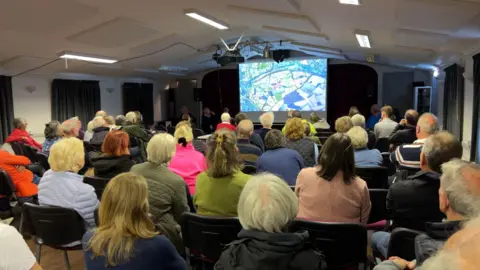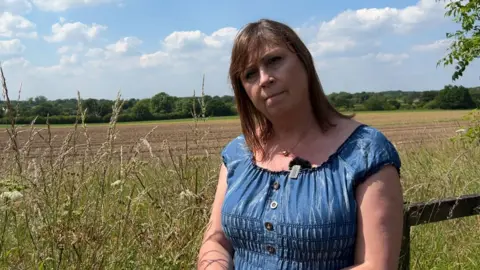Housing and the green belt puts politics on tricky turf
 BBC
BBCShrewley Village Hall in rural south Warwickshire is not exactly known for attracting large crowds.
But last month, residents packed out the venue in scenes akin to a sold-out pop concert.
The headliner? A local campaign group opposing a plan to build 4,500 new homes in the Hatton area.
"It’s going to have a major impact on wildlife and the tranquillity of the area," said Paul Tilley, a campaigner with Keep Hatton Station Rural.
Housing has been a policy battleground ahead of the general election.
The government estimates that 300,000 new homes are needed per year to account for the growing population, and political parties have different ideas about how - and most awkwardly where - to build them.
 BBC News
BBC NewsLocal authorities review the need for housing in a local plan.
Stratford-on-Avon and Warwick district councils are working on a new local plan after estimating 35,000 new homes are needed by 2050.
Developers from the Hill Group want to include 650 acres (263 hectares) of land around Hatton Railway Station in the local plan.
Although no final decisions are expected for years yet, the PR battle for hearts and minds is building.
For Andrea Ashmore, she's concerned about the lack of infrastructure and the loss of farmland.
"Small-scale farming of this nature is absolutely essential for local food production," she said. "And we can’t afford to lose this."
"Once it’s gone, it’s gone. We'll never be able to get it back."
The developer says existing rail links to Birmingham and London make Hatton a desirable location.
A spokesperson for the Hill Group said: "If it is identified as suitable, our plans will respond to both the climate and housing crisis by creating a truly sustainable new community, including three new schools and a healthcare hub, making the most of existing public transport infrastructure."
 BBC News
BBC NewsFor renters who can't afford their own home, the housing market poses different challenges.
In Coventry, thousands more homes are needed for the city’s growing population.
With limited space in the city, demand is much greater than supply.
In 2022, a report by the Countryside Charity said there was enough brownfield land to build 1.2 million new homes.
The Centre for Cities and other think tanks have argued millions more homes than that are needed and the release of at least some green-belt land is necessary to build them.
So is it time to loosen our grip on the green belt?
In Coventry and Warwickshire, there "needs to be some slack in the green belt to accommodate population growth," said Anthony Breach, a senior housing analyst at the Centre for Cities.
"If that doesn't happen, the natural consequence is that housing is going to become even more unaffordable."
The cost of renting is already squeezing many household budgets.
Kingsford Edwards lives with his wife and daughter in Coventry, where he's been renting since 2015.
He works full-time and hopes to buy his own home one day.
But earlier this year, his rent was increased by £100 a month, leaving him struggling to pay his bills.
"I have a bill that I need to pay for my mum, which is £26, and I haven't been able to pay," Mr Edwards said.
He said he and his family had been "living by credit cards and loans".
He added: "If it becomes too much, what will I do? Maybe I'll become homeless, I don't know. But if I can afford to get a cheaper place, I will move."
 BBC News
BBC NewsHousing has been one of the big topics up for debate during the election campaign.
All parties say they want to protect the green belt while building many more affordable homes.
Now voters will decide which party has the best ideas about where to put them.
Party policies on housing:
- Labour says it wants to build 1.5 million homes over the next parliament by reforming planning rules and developing poor-quality areas in the green belt, dubbed "grey belt"
- The Conservatives are promising to deliver 1.6 million homes in the same period by scrapping some environmental regulations and fast-tracking developments on brownfield sites
- The Lib Dems say they'll build 380,000 homes a year and increase protections for renters, including making three-year tenancies the default
- The Greens say they would require councils to spread small developments across their areas, provide 150,000 new social homes every year, and introduce rent controls
- And Reform UK has pledged to fast-track planning for development of brownfield sites, and offer tax incentives to encourage landlords into the rental market
A full list of candidates standing in the Kenilworth and Southam constituency is available on the BBC website.

